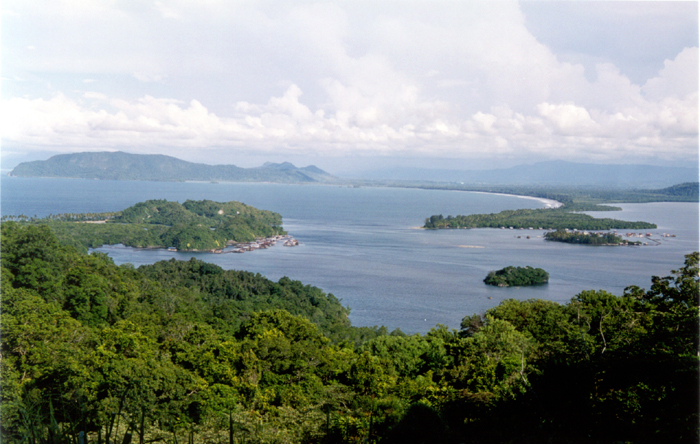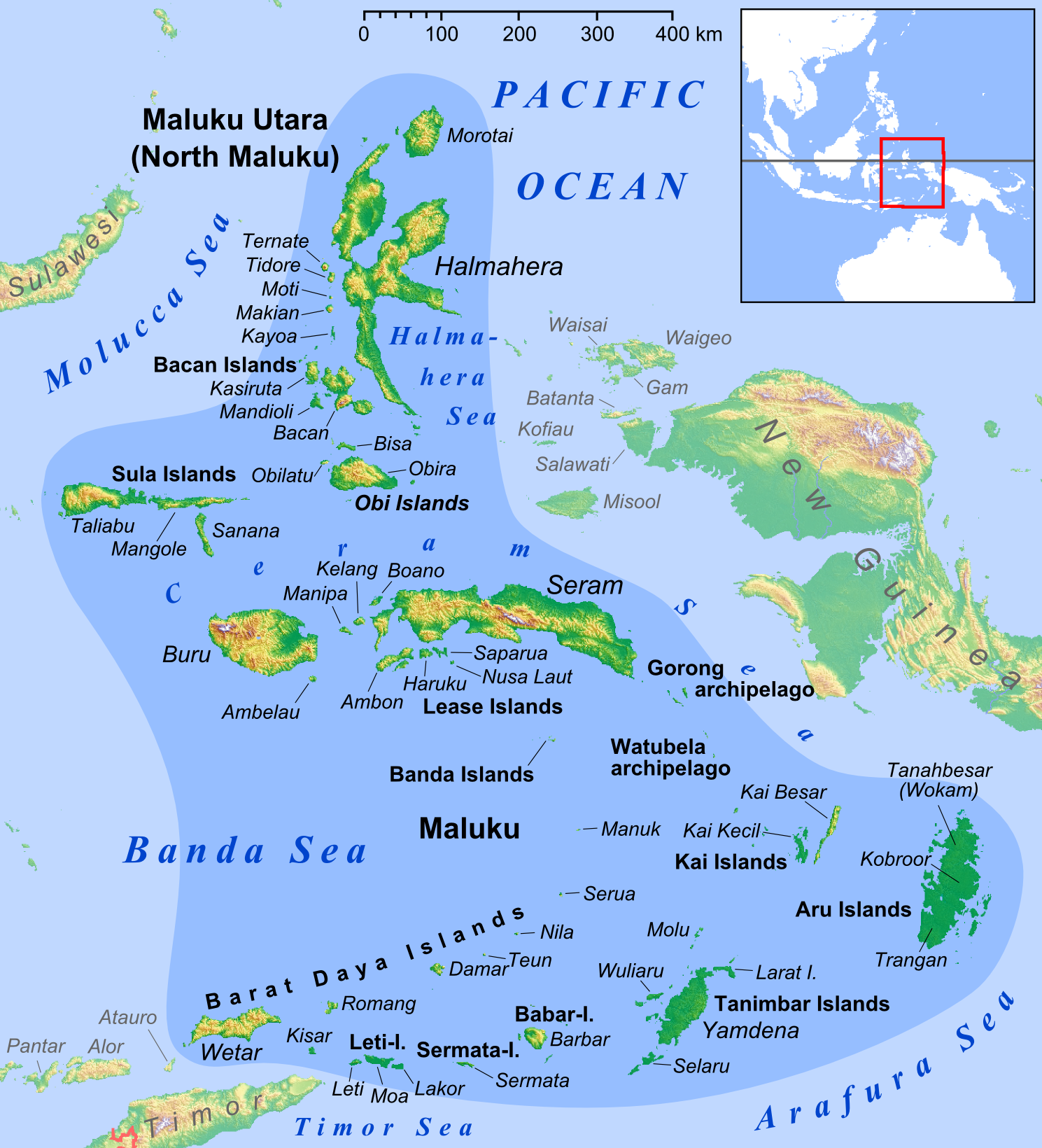|
Brown-headed Crow
The brown-headed crow (''Corvus fuscicapillus'') is a passerine bird of the genus ''Corvus'' in the family Corvidae. Endemic to Indonesia, it has a fragmented distribution in subtropical or tropical moist lowland forest and subtropical or tropical mangrove forest. It is threatened by habitat destruction and the IUCN has rated it as being "near-threatened". Description The brown-headed crow grows to a total length of about including a tail. It has the typical glossy purplish-black plumage of many of the crow genus apart from the head and neck which are a dark brownish-black. The tail has a squared-off end. The massive beak is compressed and has a high arch, being black in males and reddish or yellowish-white with a black tip in females and juveniles. The legs are black and the face is well-feathered. The nasal bristles are distinctly parted and the throat feathers are bristly. The call is a harsh caw, either in brief, two-syllable utterances or as longer, drawn-out sounds. Distr ... [...More Info...] [...Related Items...] OR: [Wikipedia] [Google] [Baidu] |
Naturalis Biodiversity Center
Naturalis Biodiversity Center () is a national museum of natural history and a research center on biodiversity in Leiden, Netherlands. It was named the European Museum of the Year 2021. Although its current name and organization are relatively recent, the history of Naturalis can be traced back to the early 1800s. Its collection includes approximately 42 million specimens, making it one of the largest natural history collections in the world. History The beginnings of Naturalis go back to the creation of the Rijksmuseum van Natuurlijke Historie (abbreviated RMNH, National Museum of Natural History) by royal decree on August 9, 1820. In 1878, the geological and mineralogical collections of the museum were split off into a separate museum, remaining distinct until the merger of the Rijksmuseum van Natuurlijke Historie with the Rijksmuseum van Geologie en Mineralogie (abbreviated RGM) in 1984, to form the Nationaal Natuurhistorisch Museum (NNM) or National Museum of Natural Hi ... [...More Info...] [...Related Items...] OR: [Wikipedia] [Google] [Baidu] |
Jayapura
Jayapura (formerly Hollandia (1910-1962), Kota Baru (1962-1963), Soekarnopura (1963-1968)) is the capital city, capital and List of Indonesian cities by population, largest city of the Indonesian Provinces of Indonesia, province of Papua (province), Papua. It is situated on the northern coast of New Guinea island and covers an area of . The city borders the Pacific Ocean and Yos Sudarso Bay to the north, the country of Papua New Guinea to the east, Keerom Regency to the south, and Jayapura Regency to the west. With a population of 398,478 according to the 2020 Indonesian census, 2020 census,Badan Pusat Statistik, Jakarta, 2021. Jayapura is the most populous city in the entire island of New Guinea, surpassing Port Moresby, the national capital and largest city of Papua New Guinea. During the 2010-2020 decade it was also the fastest-growing city in Indonesia, with the population increasing by 55.23% between 2010 and 2020.Biro Pusat Statistik, Jakarta, 2011. The official estimate a ... [...More Info...] [...Related Items...] OR: [Wikipedia] [Google] [Baidu] |
Taxa Named By George Robert Gray
In biology, a taxon (back-formation from ''taxonomy''; : taxa) is a group of one or more populations of an organism or organisms seen by taxonomists to form a unit. Although neither is required, a taxon is usually known by a particular name and given a particular ranking, especially if and when it is accepted or becomes established. It is very common, however, for taxonomists to remain at odds over what belongs to a taxon and the criteria used for inclusion, especially in the context of rank-based (" Linnaean") nomenclature (much less so under phylogenetic nomenclature). If a taxon is given a formal scientific name, its use is then governed by one of the nomenclature codes specifying which scientific name is correct for a particular grouping. Initial attempts at classifying and ordering organisms (plants and animals) were presumably set forth in prehistoric times by hunter-gatherers, as suggested by the fairly sophisticated folk taxonomies. Much later, Aristotle, and later stil ... [...More Info...] [...Related Items...] OR: [Wikipedia] [Google] [Baidu] |
Birds Described In 1859
Birds are a group of warm-blooded vertebrates constituting the class Aves (), characterised by feathers, toothless beaked jaws, the laying of hard-shelled eggs, a high metabolic rate, a four-chambered heart, and a strong yet lightweight skeleton. Birds live worldwide and range in size from the bee hummingbird to the common ostrich. There are over 11,000 living species and they are split into 44 orders. More than half are passerine or "perching" birds. Birds have wings whose development varies according to species; the only known groups without wings are the extinct moa and elephant birds. Wings, which are modified forelimbs, gave birds the ability to fly, although further evolution has led to the loss of flight in some birds, including ratites, penguins, and diverse endemic island species. The digestive and respiratory systems of birds are also uniquely adapted for flight. Some bird species of aquatic environments, particularly seabirds and some waterbirds, have furthe ... [...More Info...] [...Related Items...] OR: [Wikipedia] [Google] [Baidu] |
Mangrove
A mangrove is a shrub or tree that grows mainly in coastal saline water, saline or brackish water. Mangroves grow in an equatorial climate, typically along coastlines and tidal rivers. They have particular adaptations to take in extra oxygen and remove salt, allowing them to tolerate conditions that kill most plants. The term is also used for tropical coastal vegetation consisting of such species. Mangroves are taxonomically diverse due to convergent evolution in several plant families. They occur worldwide in the tropics and subtropics and even some temperate coastal areas, mainly between latitudes 30° N and 30° S, with the greatest mangrove area within 5° of the equator. Mangrove plant families first appeared during the Late Cretaceous to Paleocene epochs and became widely distributed in part due to the plate tectonics, movement of tectonic plates. The oldest known fossils of Nypa fruticans, mangrove palm date to 75 million years ago. Mangroves are salt-tolerant ... [...More Info...] [...Related Items...] OR: [Wikipedia] [Google] [Baidu] |
Maluku (province)
Maluku is located in Eastern Indonesia and geographically located in West-Melanesia, between Sulawesi and Western New Guinea, and comprises the central and southern regions of the Maluku Islands. It is directly adjacent to North Maluku, Southwest Papua, and West Papua (province), West Papua in the north, Central Sulawesi, and Southeast Sulawesi in the west, the Banda Sea, Australia, Timor-Leste and East Nusa Tenggara in the south and the Arafura Sea, Central Papua and South Papua in the east. The land area is 46,158.26 km2, and the total population of this province at the 2010 census was 1,533,506 people,Biro Pusat Statistik, Jakarta, 2011. rising to 1,848,923 at the 2020 census,Badan Pusat Statistik, Jakarta, 2021. the official estimate as at mid 2024 was 1,945,648 (comprising 983,943 males and 961,705 females).Badan Pusat Statistik, Jakarta, 28 February 2025, ''Provinsi Maluku Dalam Angka 2025'' (Katalog-BPS 1102001.81) The largest city and capital of Maluku province is A ... [...More Info...] [...Related Items...] OR: [Wikipedia] [Google] [Baidu] |
Aru Islands
Aru or ARU may refer to: Education * Alpha Rho Upsilon, a defunct fraternity in the United States * Anglia Ruskin University, a university in England * Ardhi University, a Tanzanian public university Places * Aru Islands Regency, a group of islands and the regency in the Moluccas * Aru, Democratic Republic of Congo, a town in Ituri province * Aru, Harju County, village in Kuusalu Parish, Harju County, Estonia * Aru, Saare County, village in Saaremaa Parish, Saare County, Estonia * Aru, Kohgiluyeh and Boyer-Ahmad, village in Gachsaran County, Kohgiluyeh and Boyer-Ahmad Province, Iran * Aru, Basht, village in Basht County, Kohgiluyeh and Boyer-Ahmad Province, Iran * Aru, Damavand, village in Damavand County, Tehran Province, Iran * Aru, Firuzkuh, village in Firuzkuh County, Tehran Province, Iran * Aru, Jammu and Kashmir, village in India * Aruba, IOC and UNDP country code ARU Sports * Fabio Aru, Italian cyclist * Army Rugby Union, organizational body for rugby union i ... [...More Info...] [...Related Items...] OR: [Wikipedia] [Google] [Baidu] |
Waigeo
Waigeo is an island in the Southwest Papua province of eastern Indonesia. The island is also known as Amberi or Waigiu. It is the largest of the four main islands in the Raja Ampat Islands archipelago, between Halmahera and about to the northwest coast of New Guinea. The Dampier Strait (a.k.a. Augusta's Strait) separates it from Batanta, and the Bougainville Strait from the Kawe Islands to its northwest. The "inner sea" that nearly cleaves the island in two is Mayalibit Bay, also known as the Majoli Gulf. The area of the island is ; the highest elevations are Buffalo Horn (Gunung Nok) and Serodjil. From west to east, the island measures approximately , north–south about . The town of Waisai in the south of the island is the capital of the Raja Ampat Regency. History Waigeo was connected to Gam and Batanta during most of the Pleistocene period, forming an island called Waitanta. Waitanta was first inhabited by humans over 50,000 years ago and excavations at Mololo ... [...More Info...] [...Related Items...] OR: [Wikipedia] [Google] [Baidu] |





